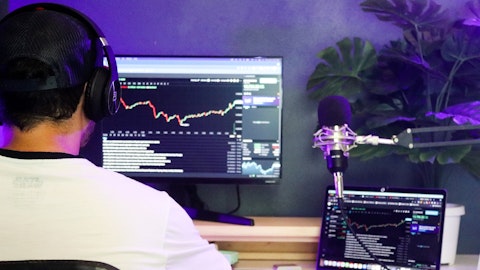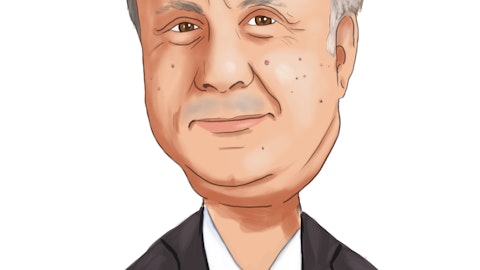Mark Kalvoda: Larry, it’s awfully far out to save for this point for next year yet. We really only have our allocations for the first part of the year at this point. It’s hard to say on the OEM side, certainly in my opinion, plant capacity is there. They’re not free of the labor challenges that the rest of the U.S. is facing right now. And then, you also have some other labor impacts there and then the supply chain. So, as it continues to improve, it could open up right now. And as we look at the business, we’re not seeing any material changes or improvement. And so with demand is strong as it is, to your question, we certainly do miss some opportunities. Now on the flip side as you know that that does elongate out the cycle that does cause the fleet to get more age does help our parts and service business as well. And so, there are some positives on that side especially with the higher margin parts and service business.
Larry De Maria: So, I hear you correctly. You might lose some sales or delay some sales, but you don’t think you’re risking losing to competitors that have maybe more availability or allocations differently? And is there any impact from the strike that you’re seeing on availability?
Bryan Knutson: At this point where we’re seeing the supply challenges really impact everybody let’s say fairly equally, and all the manufacturers and all the OEMs. So, yes, more of a, as you said, more about timing or more of a delay on the purchases for the customers versus and overall share loss at this point.
Larry De Maria: Okay. And then secondly, can you talk with the average price increases you’re seeing this year, on new orders that you’re taking in on the age, predominately on the large ag?
Bryan Knutson: Yes, it really depends on by piece and by product category, but overall, it’s in that high single digits on average as they come through, but, again, it does really vary by product, even Larry.
Larry De Maria: Okay. And last question, one more, sorry. You talked about M&A and good runway. Are there some of the larger deals still out there? Are we kind of done most of the larger deals and things now we’re kind of onesie-twosie in the footprint or there’s some meaty things out there still?
Mark Kalvoda: No, I think there’s, there’s both out there, Larry. As you just looking at some of these larger deals, the capital increases, you starting to see in this equipment between that $5.5 million up to $1 million for a combine and heads, right. So, if you take a dealer, maybe he’s grown from three stores, also as eight stores, and also you start taking in trade-ins and everyone, the cap on these exponentially increases. So, yes, I definitely think there’s going to be so motivated larger groups, but and then there’s some of the one, two store of tuck-in operations through it. So, I think they’re both out there. So, I think we there’s going to be opportunities on all different sizes of acquisitions here.
Operator: Thank you. We’re showing time for one final question today. Our final questioner is going to be Mig Dobre of Baird. Please go ahead.
Mig Dobre: Thank you for squeezing me in. Mark congrats, all the best in next step in your career, and Bo welcome. I guess my question is. I’m trying to get a better sense for the updated guidance and the variance versus the prior one. What surprised you the most basically what led to this guidance increase? Can you talk a little bit through that?
Mark Kalvoda: Sure. Thanks Mig for the congrats there. Yes, I think the two biggest areas was in equipment than it was the equipment revenue side. Again, this kind of comes to goes to the level of deliveries coming in, that it was better than what we had projected. And when it’s coming in, they’re going out fairly quickly. So from a revenue standpoint, mostly on the equipment side, there was some — and I would say that was across both Ag and Construction. From a margin standpoint than it would be on the equipment, margins as well. So we did pull that up. I think even on the manufacturer incentive. And we talked about recognizing 2 million here in the quarter. The model assumes about another 2.5 in the fourth quarter, so that it’s higher than what we expected.
But just overall, margins continued to trend higher and look better on the equipment side. And that’s and those two are the primary increases here for the fourth quarter and what happened in the third quarter as well.
Mig Dobre: And in terms of your comment on equipment availability being the and maybe better than you anticipated. As you talk to the OEM, was there some clarification as to what led to that and whether or not this is sustainable on a go forward basis?
Bryan Knutson: Yes, I think what it was, again, I think we’ve kind of go back to a fourth quarter last year, and we have some. Fourth quarter last year, there was some cancellation of orders. There were some delays of orders that went into first quarter this year. So we anticipated some level of delays for the most part this year. And particularly here in the third quarter, and that, it didn’t come to pass as much as what is actually happening here. So, it’s better than what we expected. I think what you’re hearing from the OEMs out there as well is that it’s moderately improving. And that’s showing up and it’s helping some of that equipment show up in our yards here.
Mig Dobre: And maybe the final question since you talked about margin being better than you expect to certainly better than I expected. As you think about the fourth quarter and your updated outlook. What sort of equipment margins, do you guys have embedded in there? How should we think about those margins sequentially or year-over-year, however you want for me?
Bryan Knutson: So year-to-date, we’re right around that 13.7, so a quarter was particularly high at over 14, but 13.7for the year. And we do expect that in the modeling. Anyways, what we’ve got modeled is for the full year to be down off that a little bit down to about 13.4 is what we have projected. And again, it’s some of those typical fourth quarter, mostly mix items that that happened where we’re expecting it to be down somewhat from what we’ve experienced, some of that mix would be less on the international side, less equipment revenues, and then just some of the bigger deals and higher price tag units going out more so in that fourth quarter that would bring it down. But for full year, the model has ended about 13.4.
Mig Dobre: And if I remember correctly in the prior year, in the fourth quarter, you had a little over $6 million of manufacturer incentives and now you’re only factoring in 2.5 for the fourth quarter. So that’s a theoretical headwind relative to the model, correct?
Bryan Knutson: Relative to fourth quarter last year, that’s correct. So our fourth quarter last year was quite high in the fourth quarter, as you pointed out. It had some of those unusual items. And yes it was like 6.4 million total of manufacturer incentives, some of some of which was on the international side, I think 1.3 was on the International side and 5.1 on the Ag side. So yes, that compares to more like 2.5 this year, in our fourth quarter. That’s correct.
Mig Dobre: Then if I may, one final question. I’m wondering why manufacturing incentives would be lower this year than they were in a prior year given the fact that the volumes are better and your business has obviously done quite well in ’23?
Bryan Knutson: Yes, and when you add, so we booked 2.6 and starting in our Q2 this year. So, the answer is we really started recognizing it earlier this year because of our confidence in achieving that incentive. So, we’ve got a total of 4.6 books so far and with the additional 2.5, we’re at like 7.1 total compared to 5.1 that was booked on the Ag side last year. So it is higher when you look at the whole year. It’s just the timing of when we began booking into our results.




